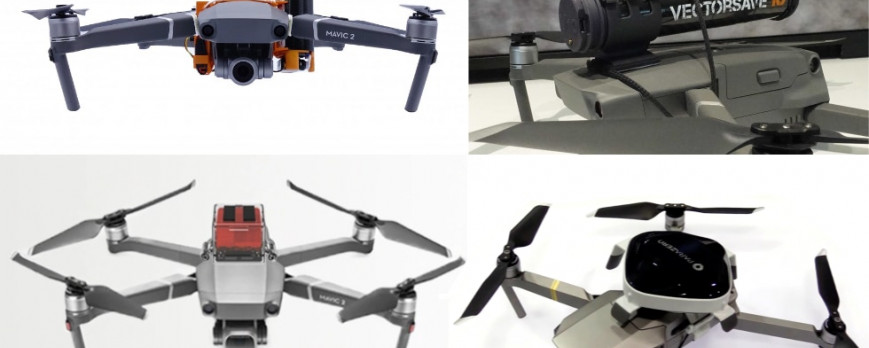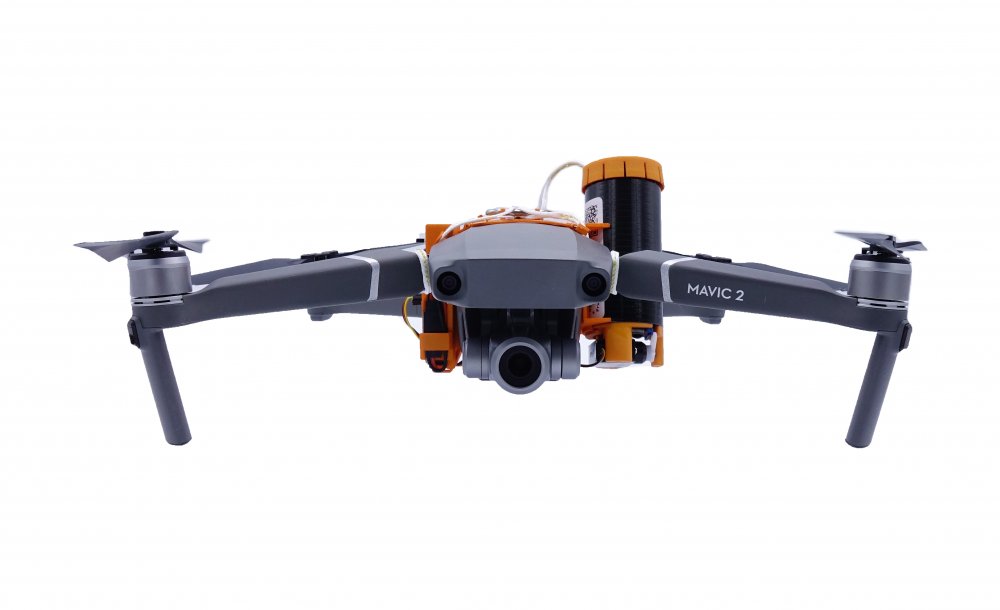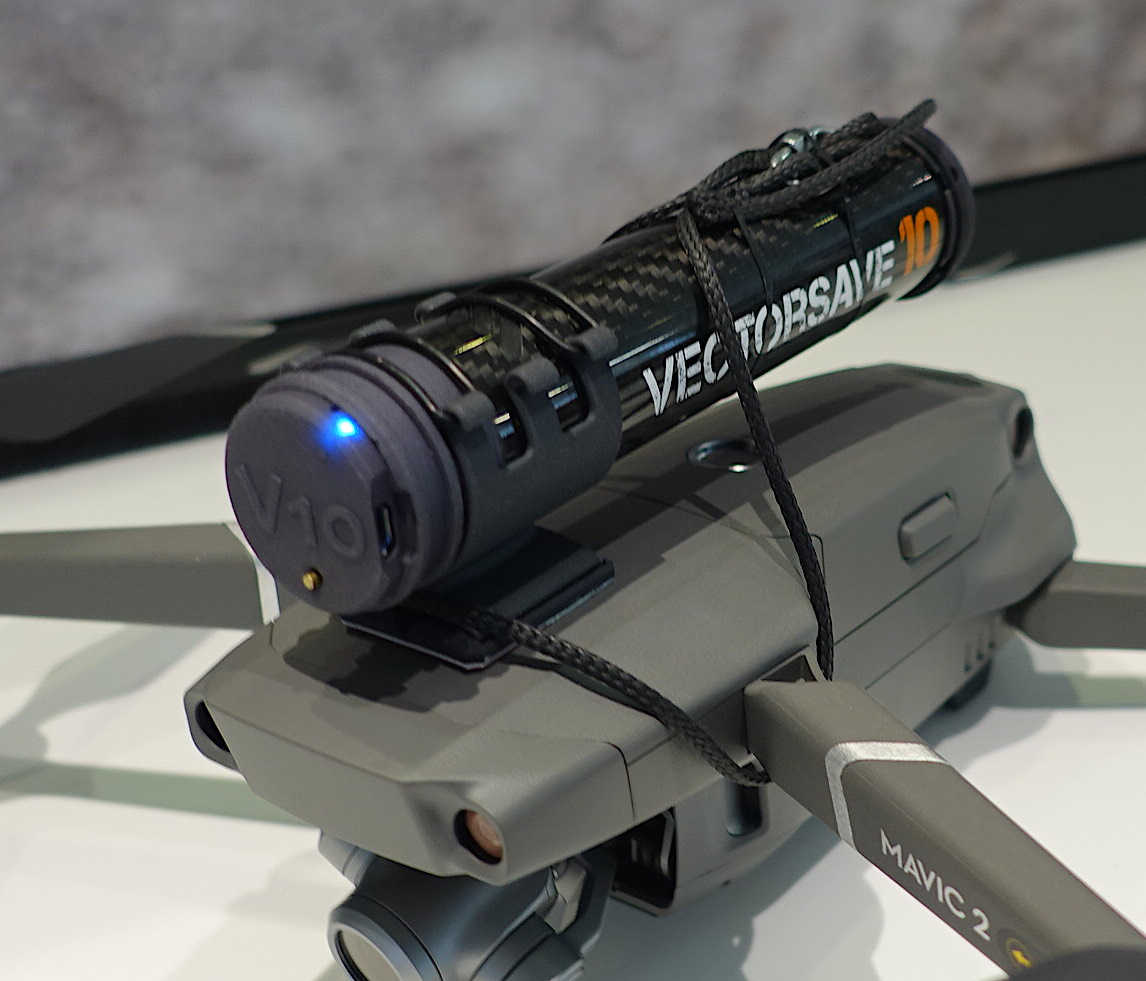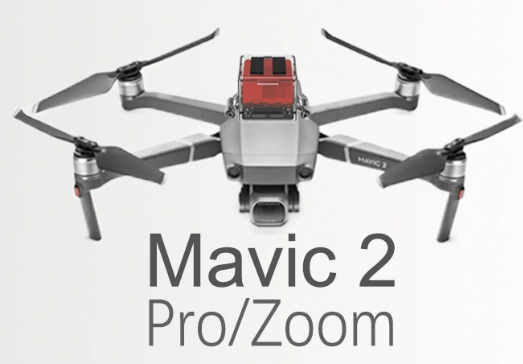No products

Parachutes for DJI Mavic 2 Pro and Mavic 2 zoom
1. Parachute for DJI Mavic 2 Pro and Mavic 2 Zoom by Fruity Chutes

-
Automatic deployment triggering: yes
-
Deployment system: servo / spring
-
Has its own power supply system: yes
-
Audible alarm: no
-
Remote control dedicated to parachute activation: yes (optional)
-
Easy folding and re-use: yes
-
Provokes engine / propeller shutdown when deployed: no
-
ASTM F-3322 / FAA Waiver: no
-
Already available: yes
-
Price: 560€ / 633$
-
Weight: 135 grams
Fruity Chutes is not at its first attempt, the parachute manufacturer whose reputation is well known had already released a parachute in 2018 for the first Mavic.
It is therefore an evolution of the original system that has proved its worth.
The system consists of a parachute and an automatic ejection system that has become almost standard on most drone parachute systems. These cards with gyroscopes, accelerometer and other motion and position sensors allow the parachute to be activated generally faster than by a human and avoid complex connections to the flight controller or drone receiver. In addition, the Automatic Trigger System (ATS) is equipped with its own battery to control the ejection of the parachute, avoiding once again the convoluted connections to a power supply present on the aircraft.
This model uses the Mayday trigger board developed since 2016 by MARS Parachute. That's a good thing, since it's the reference in terms of automatic triggering.
The system adapts to the two drones in the Mavic 2 range: the Mavic 2 Pro and the Mavic 2 Zoom.
The complete system with battery, parachute, automatic release system and mounting kit weighs only 135 grams and can support from 1.2 to 2.4kg.
The parachute is the IFC-30-SUZ model with 6 lines that can each support 90 kilos, a Fruity Chutes best seller that equips many of the manufacturer's drone parachute systems. As usual at Fruity Chutes, the quality is excellent, whether for the fabric of the parachute, the lines or the fixing straps.
The launcher is composed of a carbon tube and a simple and reliable ejection system by spring released by a servo. One of the most widely used mechanisms for UAV parachute systems for its reliability, light weight and absence of CO2 or pyrotechnic systems, which makes it easy to take it on a flight while traveling.
Everything is included, even the battery, in this kit, which can also be ordered as a kit to be assembled yourself or as an RTF (Ready To Fly) system.
This system can also be completed by a radio control system, which will make it possible to comply with the regulations of certain countries that require a remote control system dedicated to the parachute. For radio control, FruityChutes has teamed up with SkyCat, whose reputation in the field of drone parachutes is also well established.
In short, a system that is reliable, robust, efficient and combines the best technologies available on the market today. If you want a parachute for your DJI Mavic 2 Pro or Mavic 2 Zoom, don't think any more, drop the 633$, install, and fly with peace of mind.
2. VectorSave™10 Mavic 2

-
Automatic deployment triggering: yes
-
Deployment system: servo / spring
-
Has its own power supply system: yes
-
Audible alarm: no
-
Remote control dedicated to parachute activation: yes (optional)
-
Easy folding and re-use: yes
-
Provokes engine / propeller shutdown when deployed: no
-
ASTM F-3322 / FAA Waiver: no
-
Already available: yes
-
Price: 318€ / 359$
-
Weight: 85 grams
It is one of the lightest of this comparison with 85 grams. It has the particularity of being mounted with a clip that makes it very easy to mount and dismount. The system is completely autonomous, whether for power supply or triggering, and therefore does not require any modification of the Mavic 2.
The system has an arming button that allows you to activate or deactivate the parachute, which is quite reassuring during the transport of the drone on site before takeoff. The status is indicated by an LED on the parachute tube.
The trigger system is equipped with a rechargeable USB battery. This USB connection also allows the firmware update of the automatic triggering system.
The VectorSave can apparently be coupled to a remote control SaveSense™ RadioSave™ dedicated to the parachute even if it is not specified on the product page.
The deployment system used is not indicated but it is probably a servo/spring system.
3. ParaZero SafeAir for DJI Mavic

-
Automatic deployment triggering: yes
-
Deployment system: unknown
-
Has its own power supply system: yes
-
Audible alarm: yes
-
Remote control dedicated to parachute activation: no
-
Easy folding and re-use: yes
-
Provokes engine / propeller shutdown when deployed: yes
-
ASTM F-3322 / FAA Waiver: yes
-
Already available: no
-
Price: 265€ / $299
-
Weight: 110 grams
Official presentation video (SafeAir for DJI Phantom)
Successor of the SafeAir model for DJI Phantom, this parachute offers interesting features such as automatic motor cut-off when deployed. Unfortunately the ParaZero is not very talkative on the subject and we don't see the system in action in the video.
Another advantage is that the system triggers an audible alarm when the parachute is deployed, which is a very good point and is even required by the regulations of some countries.
The system is equipped with a black box that records the flight parameters and even has its own GPS to analyze and understand what caused the incident.
But its most interesting feature is that it is in accordance with the new American standard ASTM F-3322. This means that it is an effective parachute and has been proven by multiple ASTM controlled tests. It may seem like a detail, but the fact that the drone is equipped with such a parachute allows (in the United States) to ask the FAA (Federal Aviation Administration) for authorizations to fly over people or places that were previously prohibited.
As with the Fruity Chutes system, an electronic board equipped with motion and position sensors detects the loss of control or free fall of the drone and automatically triggers the parachute. But the triggering is only automatic, there is no dedicated radio control system.
On the manufacturer's page there are mentions like "The only completely autonomous drone rescue system", it's not that bad but still a little untruthful. In any case, it invites us to be cautious of ParaZero's other statements.
The SafeAir for Mavic 2 Pro and Mavic 2 Zoom weighs 110 grams, a little lighter than the Fruity Chutes system.
The ParaZero parachute system seems to be of good quality, autonomous (power supply and release), well designed, lightweight and stylish. An interesting system even if some further informations are missing for the moment.
SafeAir is expected to be commercialized at around US$299. This is at least the price of SafeAir for DJI Phantom and we can expect a similar price for the Mavic version.
4. Flyfire mantis (Indiegogo project, not yet ready yet)

-
Automatic deployment triggering: yes
-
Deployment system: unknown
-
Has its own power supply system: yes
-
Audible alarm: no
-
Remote control dedicated to parachute activation: no
-
Easy folding and re-use: yes
-
Provokes engine / propeller shutdown when deployed: no
-
ASTM F-3322 / FAA Waiver: no
-
Already available: no
-
Price: unknown
-
Weight: 25 grams
Despite the Indiegogo project url https://www.indiegogo.com/projects/the-activity-has-stopped/coming_soon, the team answers all questions on the project's youtube video and confirms that it is still on the agenda.
In the comments of the video are some information that are not present on the Indiegogo page. We learn among other things that:
The Manti parachute goes into pause mode when its sensor detects the takeoff of the drone.
When the drone hits an obstacle, free falls, rotates more than reasonably on its axis of pitch or roll, in short when it is out of control. The Manti activates and deploys the parachute. And he doesn't deploy it randomly, the Manti waits for the Mavic to be in the ideal position to deploy. If, for example, the Mavic is in the middle of a roll, then the Manti will wait until the top surface of the drone is oriented towards the zenith in order to optimize the deployment time and to prevent the drone from falling into its own parachute.
Every second, the Manti sensor performs 600 calculations, 300 altitude measurements and 50 measurements of various flight parameters.
What is impressive about this system is its weight: only 25 grams all-inclusive: parachute, ejection system, mini solar panel, battery, sensor.
The solar panels on the top of the parachute allow it to standby for 60 days but it is of course still possible to charge it using the USB port integrated into the card/sensor which is equipped with a battery.
The parachute and card are protected by a plastic shell that protects them from dust and water.
The Flyfire team announces a trigger time of 0.19 seconds.
In the video, the parachute seems to be ejected by a pyrotechnic or CO2 system but there is no explanation on the ejection system used.
The Manti also adapts to other small DJI drones: Mavic Spark, Mavic Air, Mavic Pro and Mavic 2 Pro & Zoom.
It is therefore a very complete and simple system to use, at least on paper, perhaps even a little too good to be true and it is best to wait for the official release of the product to see if the Flyfire team will be able to keep its promises.
Conclusion
The Fruity Chutes system is the most advanced at the moment, it is a summary of the best technologies available today. But the ParaZero SafeAir is also very interesting thanks to features such as audible alarm, engine shutdown and especially ASTM F-3322 certification. But the latter is not yet available for sale at the moment. For smaller budgets, the VectorSave is a good alternative. As Flyfire's Manti is only a concept for the moment, we will wait until the project is completed before paying more attention to it.
Leave a CommentLeave a Reply
Blog archives
Featured Products
Latest Comments
-
POPPRE Zoltan
on Parachutes, DGAC, drones and S3 scenario - New... -
Marchico Robert
on Rescue parachutes for multirotor drones -
Gaël Billon
on Automatic parachute deployment with Pixhawk -
Gaël Billon
on Automatic parachute deployment with Pixhawk
Blog search
New products
No New products








